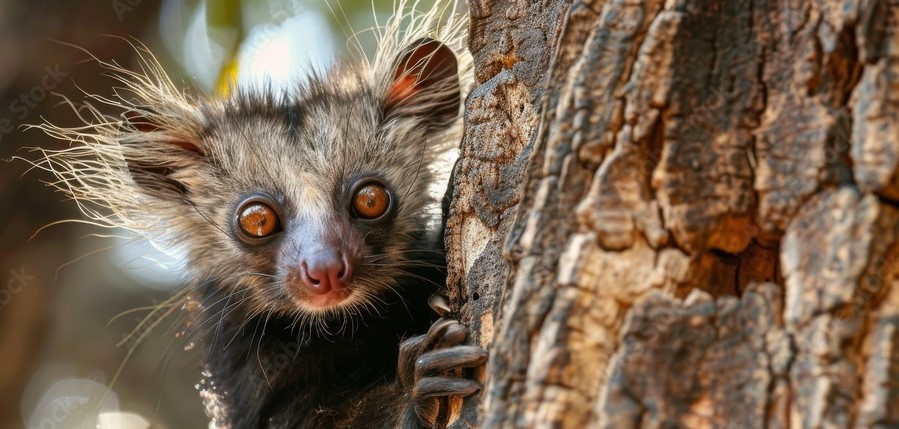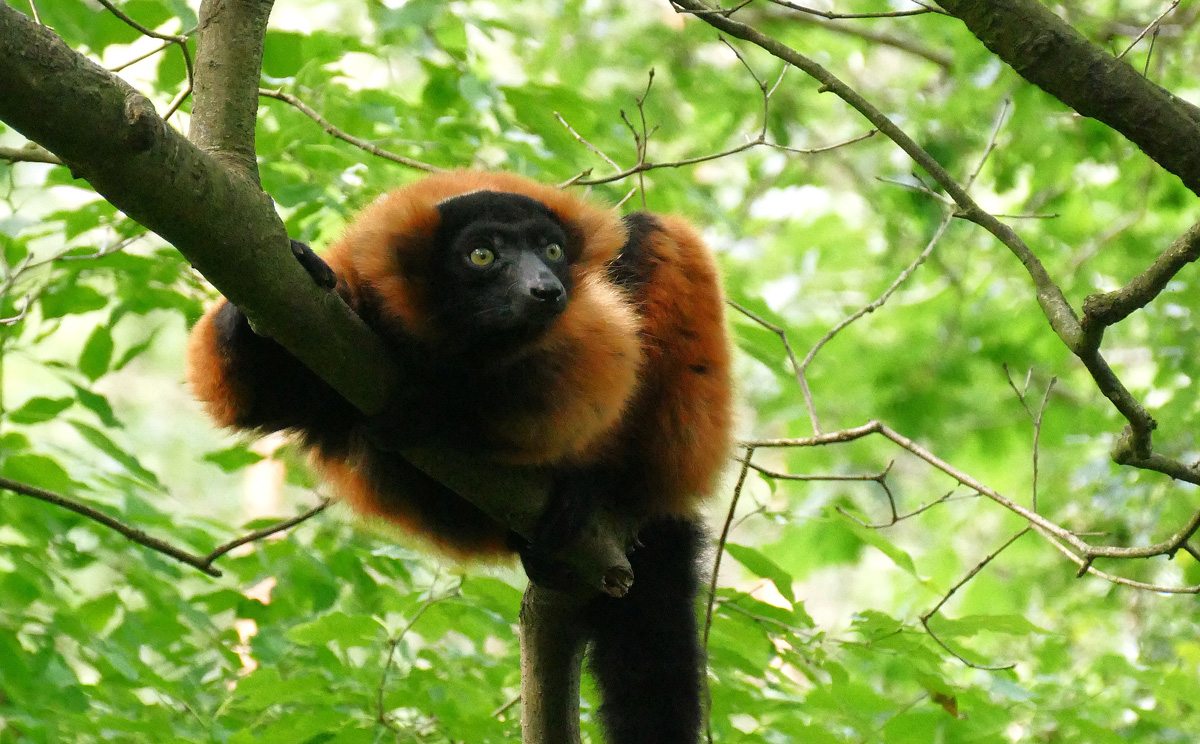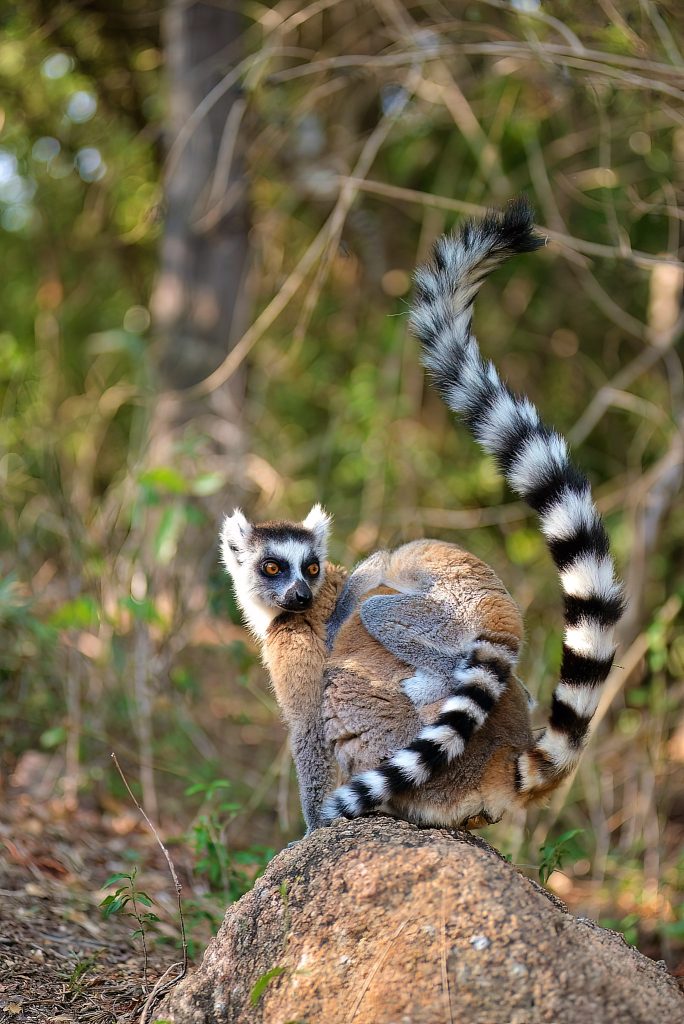Madagascar is a treasure trove of unique wildlife, but perhaps none more famous or fascinating than its lemurs. These incredible primates are endemic to Madagascar, meaning you won’t find them anywhere else in the world. Their diversity, behavior, and ecology make them a highlight for international tourists eager to explore the island’s unique environment. Whether you are a wildlife enthusiast or a curious traveler, the chance to see these lemurs in their natural habitat is reason enough to visit Madagascar.
In this article, we’ll introduce you to 5 fascinating species of lemurs that make Madagascar one of the most biodiverse places on Earth.
1. Ring-Tailed Lemur (Lemur catta)
The Ring-Tailed Lemur is one of Madagascar’s most iconic animals. With its long, bushy, black-and-white-striped tail, it’s hard to miss! Found in the dry forests and bushlands of southern and southwestern Madagascar, the Ring-Tailed Lemur is known for its social nature and unique behaviors.
Fascinating Facts:
- Unlike most lemurs, which spend their time in trees, the Ring-Tailed Lemur is known for being highly terrestrial, often found walking on the ground in search of food.
- They live in groups, or “troops,” that can consist of up to 30 members, with females leading the pack—a rare phenomenon in the primate world.
- Their long tail, while not prehensile, is used as a visual signal to help keep the group together when moving through the forest.
Where to See Them: The best places to observe Ring-Tailed Lemurs are Isalo National Park and the Anja Community Reserve in southern Madagascar.
2. Indri (Indri indri)
The Indri, also known as the “babakoto” in Malagasy, is the largest lemur species and is famous for its haunting, melodic calls that can echo through the forests for kilometers. Residing in the rainforests of eastern Madagascar, the Indri holds a special place in Malagasy culture, often regarded as a sacred animal.

Fascinating Facts:
- The Indri is a tailless lemur, which makes it unique among other lemurs.
- Their calls are used to communicate with other Indri groups and mark their territory. These songs are often compared to whale songs or the calls of gibbons.
- The Indri’s strong hind legs allow it to leap distances of up to 10 meters (33 feet) between trees, a stunning display of agility in the treetops.
Where to See Them: Visit Andasibe-Mantadia National Park, just a few hours from Antananarivo, to hear and see the Indri in their natural habitat.
3. Aye-Aye (Daubentonia madagascariensis)
Of all Madagascar’s lemurs, the Aye-Aye is perhaps the most unusual and mysterious. This nocturnal lemur is known for its bizarre appearance—large eyes, elongated fingers, and rodent-like teeth—which give it an almost mythical reputation among locals. It’s even considered a harbinger of bad luck in some Malagasy cultures, though it plays an important role in the ecosystem.

Fascinating Facts:
- The Aye-Aye’s long middle finger is used for percussive foraging, tapping on trees to locate hollow cavities where insect larvae hide. Once found, the lemur uses its specialized finger to scoop the larvae out.
- It is the largest nocturnal primate in the world, making it a truly rare sight during night hikes.
- Despite its fearsome reputation, the Aye-Aye is vital to Madagascar’s forests as it helps control insect populations.
Where to See Them: The best place to spot Aye-Ayes is on a night hike in Mananara-Nord National Park or Nosy Mangabe Special Reserve.
4. Sifaka (Propithecus)
Sifakas are known for their “dancing” behavior, which is a result of their remarkable ability to leap across the ground in a sideways hopping motion. There are several species of Sifaka in Madagascar, but two of the most well-known are the Verreaux’s Sifaka and the Diademed Sifaka.

Fascinating Facts:
- The Verreaux’s Sifaka, also known as the “dancing lemur,” is famous for its bipedal movement. When on the ground, it moves with grace, leaping sideways with its arms outstretched for balance.
- The Diademed Sifaka is one of the most beautiful lemurs, with a striking fur pattern that includes gold, black, white, and gray. It lives in the lush rainforests of eastern Madagascar.
- Sifakas are herbivores, feeding primarily on leaves, fruits, and flowers.
Where to See Them: Kirindy Forest for Verreaux’s Sifaka and Andasibe-Mantadia National Park for the Diademed Sifaka.
5. Red Ruffed Lemur (Varecia rubra)
Endemic to the northeastern rainforests of Madagascar, the Red Ruffed Lemur is one of the most colorful lemur species. With a striking reddish-brown coat and a black face, these arboreal creatures are incredibly vocal and active, often heard before they are seen.

Fascinating Facts:
- Red Ruffed Lemurs are highly vocal, using loud, barking calls to communicate with others in their group.
- They are excellent seed dispersers, making them key players in maintaining the health and diversity of Madagascar’s rainforests.
- These lemurs are also notable for their cooperative care of infants, with females sometimes sharing the task of caring for each other’s young.
Where to See Them: Masoala National Park on the Masoala Peninsula is the only place where you can find Red Ruffed Lemurs in the wild.
Why Madagascar’s Lemurs Are So Special
Madagascar is home to over 100 species of lemurs, all of which are endemic to the island, making it a truly unique destination for wildlife lovers. These fascinating creatures have evolved over millions of years in isolation, creating an extraordinary diversity of behaviors, adaptations, and ecological roles. Unfortunately, many lemur species are also critically endangered due to habitat loss and poaching, making conservation efforts crucial to their survival.
By visiting Madagascar, you are not only experiencing a once-in-a-lifetime wildlife adventure but also supporting conservation efforts that help protect these incredible animals and their ecosystems.
Madagascar’s lemurs are a symbol of the island’s rich biodiversity and offer an unparalleled opportunity for travelers to witness nature at its unique. Whether it’s the social Ring-Tailed Lemur, the singing Indri, the mysterious Aye-Aye, or the graceful Sifaka, each of these species provides a window into the extraordinary wildlife of Madagascar. Plan your trip to Madagascar to experience these lemurs up close and support the preservation of one of the planet’s most precious ecosystems.
Related posts
Meet the project

Welcome to Wonderful Madagascar, a non-profit project created by a passionate Malagasy team with one mission: to reveal the hidden beauty of Madagascar to the world. From its rare and captivating wildlife to its stunning landscapes and pristine beaches, we are dedicated to promoting the richness of this extraordinary island.
Learn more
